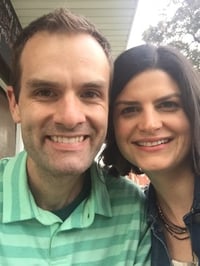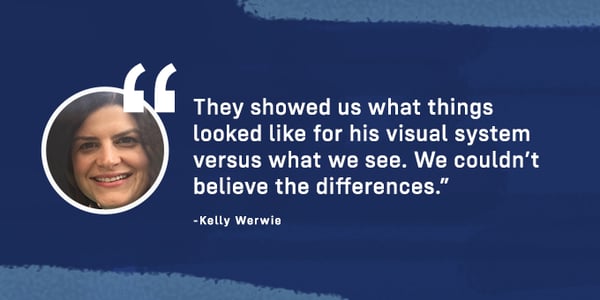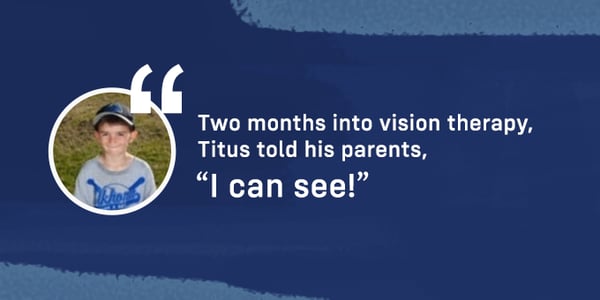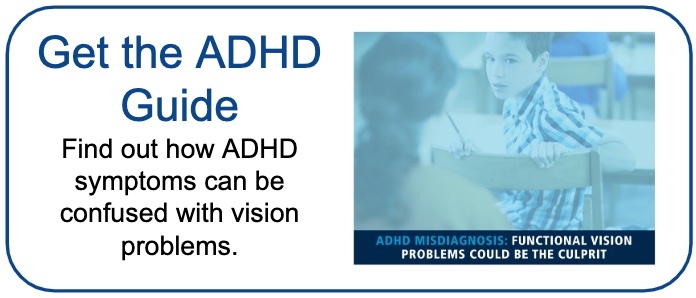
Ask any teacher -- it’s a lot to expect a young child to sit and be attentive in school, especially in preschool or kindergarten. Kids are distracted. Kids want to play.
But Titus was different.
“I could never capture his attention one-on-one,” Titus’s mom Kelly Werwie recalled. “In preschool, he would get distracted and throw himself to the ground.”
Like many children, Titus was showing all the classic symptoms of Attention Deficit Hyperactive Disorder (ADHD). But his mother Kelly had a suspicion that there was something else affecting her son. It turned out she was right.
Like many parents, Kelly and her husband Tim wondered if Titus’s behavior was a function of age and school-readiness. But her mom’s intuition told her something else was at play. Fortunately, so did her eye doctor.
 Tim and Kelly Werwie
Tim and Kelly Werwie
Symptoms That Present Themselves as ADHD
The Werwies had taken Titus for a routine eye exam. Their optometrist, Dr. Moses, noticed something out of the ordinary.
“He told us Titus’s eyes weren’t working together like they should,” Kelly said.
Dr. Moses informed her that Titus might be suffering from a functional vision problem, which can include symptoms that resemble ADHD.
Functional vision involves the entire visual system, and the visual skills including eye movement, eye tracking and eye focus. These visual skills impact things such as depth perception, or your ability to track words along a line of text.
Dr. Moses referred Titus to The Vision Therapy Center for testing.
Bonus Content: Watch Kelly and Tim Werwie tell their story.
Understanding What Titus was Seeing
The Vision Therapy Center is owned by Dr. Kellye Knueppel and staffed with developmental optometrists and vision therapists who specialize in treating functional vision problems.
Titus underwent a Functional Vision Exam, and afterwards, the Werwie’s were shown the results.

“They showed us what things looked like for his visual system versus what we see. We couldn’t believe the differences,” Kelly said. “We thought, ‘Wow, we really understand.’ ”
Titus was diagnosed with refractive amblyopia, convergence excess, and irregular saccades. Dr. Brandon Begotka recommended 36 sessions of vision therapy.
Undertaking vision therapy would be a commitment, both in terms of time and money. It would take 36 sessions of vision therapy -- a series of activities and exercises designed to retrain the visual system -- including a weekly in-office visit.
The therapy also wasn’t covered by their insurance.
But the family knew they had no choice but to help Titus. They began vision therapy.
Getting the Visual Team to Work Together
Titus practiced the vision therapy activities every day for about an hour at home, usually in the morning. Once a week, they would visit The Vision Therapy Center for a session with a vision therapist.
This is hard work for anyone, especially a seven-year-old. Titus did his vision therapy activities in the morning, when his visual system was rested. And soon, he showed improvement:

“I can see” - Two months into vision therapy, Titus told his parents, “I can see!” His vision was 20/20, a sign that he was focusing properly.
Dressing himself in the morning - In the morning, Titus used to struggle dressing himself. “Now he’s the first person dressed in the morning, and he gets his own breakfast together. “Before, there was no way he would do that,” Kelly said. “He wouldn’t even try.”
Teaching himself to ride a bike - Titus had never wanted to ride a bike, likely due to his poor depth perception. After vision therapy, he not only wanted to ride a bike, but he asked his parents to take the training wheels off and he taught himself.
Swimming no longer a struggle - Swimming lessons had long been a challenge for Titus. Now he was swimming with confidence, and happy to jump off a five-foot diving board.
Doing well in math and science - Not only is Titus not flopping on the floor, but he’s enjoying math and science.
“A Completely Different Child.”
In terms of schoolwork, despite Titus’s progress, Kelly notes that it’s not reasonable to compare him to other students. He’s playing catch-up from years of coping with the vision problem, and they’re going to start to work with a reading specialist to keep him moving along.
Titus is, however, making steady progress. The schoolwork will come in time. What’s important is Titus’s improvement in all walks of life.

The Werwie family
“The biggest statement I can make is that he is a completely different child from where he started nine months ago,” Kelly said. She recalled a recent appointment, in which she had to talk to Dr. Begotka for twenty minutes. Titus sat there patiently and quietly, a stark contrast to his ADHD-like behavior of months prior.
“He’s calm and focused, and he does his work,” Kelly said. “He now has confidence. It’s like he’s saying, ‘I’ve got this.’”
Do you think your child's ADHD-like symptoms may be the result of a functional vision problem? Schedule a Functional Vision Exam.
To learn more about how ADHD can be confused with functional vision problems, download our ADHD Guide.
Titus Werwie’s Functional Vision Problem - A Clinical Overview
In this section, we share some of Titus’s diagnosis and clinical progress for fellow optometrists and medical practitioners.
Initial Diagnosis
Refractive Amblyopia
Convergence Excess
Irregular Saccades
Accommodative Insufficiency (left eye)
Visual Acuity
|
Unaided |
Far |
Near |
|
OD |
20/20 |
20/20 |
|
OS |
20/30 |
20/20 |
Near Point Convergence
|
Pre-Vision Therapy |
|
|
NPC |
2”/3” |
|
After 5x |
1”/2” |
|
With red lens |
2”/3” |
|
Post-Vision Therapy |
|
|
NPC |
T.N. |
|
After 5x |
T.N |
|
With red lens |
0.5”/1” |
Vergence Ranges
|
Pre-Vision Therapy |
||
|
FAR |
FAR |
NEAR |
|
BI |
8/2 |
14/10 |
|
BO |
20/12 |
No break to 40 |
|
Post-Vision Therapy |
||
|
FAR |
FAR |
NEAR |
|
BI |
X/16/0 |
X/22/0 |
|
BO |
X40/0 |
X/40/18 |
Accommodative Amplitudes
|
Pre-Vision Therapy |
|
|
OD |
8/8 |
|
OS |
10/9 |
|
Post-Vision Therapy |
|
|
OD |
8/8 |
|
OS |
8/8 |
Take the Vision Quiz: The First Step Toward Detecting a Problem
If you think you or your child may be suffering from a functional vision problem, the first step toward diagnosis is to take The Vision Quiz. It can help you identify if you’re suffering from any of the symptoms associated with a functional vision problem.



